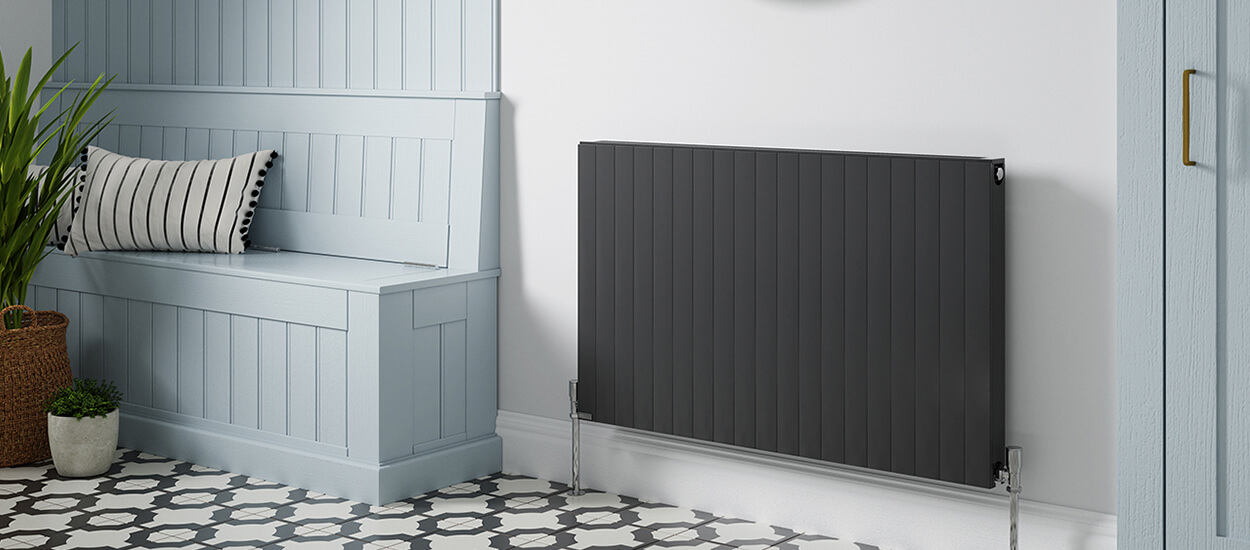Draping damp clothes over a radiator can be a common practice in homes lacking outdoor drying spaces or during the colder months. However, this seemingly harmless habit poses several safety and health risks, from increasing fire hazards to fostering mould growth and impacting the efficiency of your heating system.
Below we’ll explore the implications of drying clothes on radiators, highlighting the health and safety concerns involved with doing so. Ideally, you’d want to introduce a safer, more efficient alternative – heated towel radiators. Designed for effective drying, these radiators offer a practical solution without the drawbacks of traditional methods, and you can find plenty of innovative designs and models here at Stelrad.
But first, is it safe to dry clothes on a radiator and what are the risks?
What Happens When Drying Clothes On A Radiator?
When you hang wet clothes on a radiator, you’re essentially introducing moisture into the air. This moisture needs somewhere to go, and in a closed environment, it increases the humidity level of the room. While it might seem like a quick fix to drying clothes by placing each item on the radiator, this method has several unintended consequences for both your home’s warmth and energy efficiency.
Impaired Heating Efficiency
Radiators are designed to heat spaces by circulating warm air. However, when clothes are draped over them, they absorb the heat, preventing it from efficiently distributing throughout the room. This means your radiator has to work harder and longer to achieve the desired room temperature, leading to increased energy consumption and higher heating bills.
Increased Energy Consumption
The added moisture from your clothes can make the air feel cooler, prompting you to turn up the thermostat. This not only consumes more energy but also puts additional strain on your heating system, potentially leading to premature wear and tear.
Understanding the process and impacts of drying clothes on radiators is essential in weighing the convenience against its hidden costs. While it may seem like a straightforward solution to laundry day challenges, especially on colder or rainy days, the practice can lead to higher energy bills and a less efficient heating system.
Health and Safety Concerns of Drying Clothes on Radiators
Drying clothes on radiators introduces more than just energy inefficiencies – it also raises significant health and safety concerns. Understanding these risks is crucial for any household looking to maintain a safe and healthy living environment.
Fire Risks
The most immediate danger of drying clothes on radiators is the potential fire hazard. Fabrics in direct contact with a heat source can overheat. Although modern radiators are designed with safety in mind, the risk increases if the radiator is old or if clothes are left unattended for extended periods.
Mold and Condensation
The moisture released from clothes as they dry indoors can lead to increased humidity levels. In poorly ventilated spaces, this moisture has nowhere to escape, settling on walls, windows, and ceilings as condensation. Over time, these damp conditions become the perfect breeding ground for mould and mildew, posing health risks, especially to those with respiratory issues or allergies.
The combined effects of impaired heating efficiency, increased energy consumption, fire hazards, and the proliferation of mould and mildew highlight the need for caution when drying clothes on radiators.
The Role of Heated Towel Radiators in Safe Clothes Drying
While hanging clothes over regular radiators presents several risks, heated towel radiators offer a safer, more efficient alternative. Designed specifically for making effortless work of drying towels and clothes, these radiators are the ideal solution for when need to hang damp items indoors.
Design and Efficiency
Heated towel radiators are engineered to dry clothes and towels effectively without compromising the heating efficiency of your home. Their design allows for ample air circulation, ensuring that moisture evaporates quickly and evenly. This design minimises the risk of damp conditions that lead to mould and mildew growth.
Versatility Beyond Bathrooms
Though commonly found in bathrooms and en-suites, heated towel radiators are versatile enough for use in other areas of the home, making ideal utility room radiators or laundry room radiators. This adaptability makes them a perfect solution for drying clothes indoors, especially in homes without outdoor drying space or during inclement weather.
Energy Considerations
You might assume that adding a heated towel radiator would increase energy consumption. However, because these units are designed to operate efficiently, they can dry clothes without significantly impacting your energy bills. By providing a dedicated drying space, they reduce the need to overload the central heating system to compensate for the humidity and coolness introduced by drying clothes on traditional radiators.
Heated towel radiators represent a smart investment as their design not only addresses health and safety concerns but also offers a practical, energy-efficient solution for any home.
Best Practices for Drying Clothes Indoors
The best way to dry clothes is outside on a clothesline, but if you absolutely have to dry clothes indoors and want to safely and efficiently, consider the following:
- Drying Racks – Place them in ventilated areas to avoid dampness without risking safety.
- Dehumidifiers – They help remove excess moisture, reducing mould risks.
- Ensure Ventilation – Open windows or use extractor fans to improve air circulation and accelerate drying.
- Rotate Clothes – Regularly rotate clothes on the rack whilst drying to speed up the process.
By considering safer alternatives like heated towel radiators and adopting best practices for indoor drying, you can ensure your home remains a safe, efficient, and healthy environment.
You can explore our range of heated towel radiators and electric towel radiators here at Stelrad, designed for optimal drying performance without compromising on style or energy consumption. If you have an existing towel radiator, we also have a towel rail electric heating element that can convert select models into a dual fuel or electric radiator. Find out more and contact us if you have any questions.

